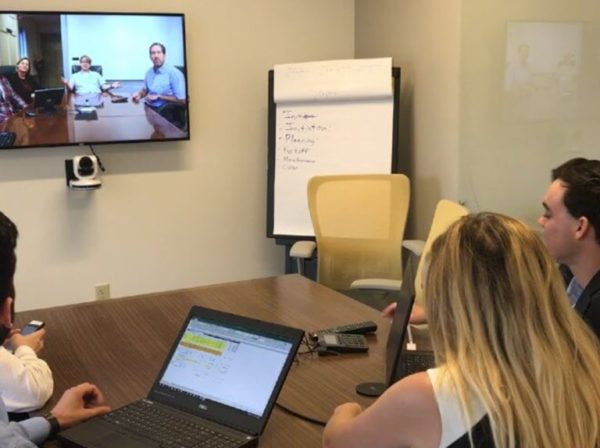SUDBURY, Mass. — June 10, 2021 — Yamaha Unified Communications is teaming up with HuddleCamHD to further enhance Yamaha’s portfolio of scalable, high-quality collaboration solutions with easy-to-deploy audio and video product bundles perfectly suited for meeting and learning spaces. Adapted for today’s evolving video conferencing and hybrid learning requirements, the bundles are designed to fit a variety of small, medium, and large meeting and teaching environments and budgets, incorporating Yamaha’s portable YVC-330 USB & Bluetooth® speakerphone, YVC-1000 USB & Bluetooth conference phone, or Yamaha’s HD Single and HD Dual wireless microphone systems.
“Great meetings and learning sessions are a result of best-in-class audio and video solutions that enable clear, distraction-free conversation,” said Michelle Baeza, Director of Strategic Partnerships at Yamaha Unified Communications. “By partnering with HuddleCamHD, we are providing our customers with more interoperable options that are easy to deploy and incredibly simple to use to ensure flawless collaboration in any room.”
Yamaha’s rich history delivering audio hardware and HuddleCamHD’s innovations in video conferencing will provide customers with scalable solutions for video conferencing, hybrid learning, and other communications from the home, office, or event space. For small rooms, the portable YVC-330 USB & Bluetooth speakerphone with SoundCap ensures the best-quality audio, no matter where a meeting happens. The YVC-1000 conference phone is an intuitive communications system featuring separate microphone and speaker units for flexibility during audio, web, and video conferencing in medium to large spaces. For large rooms such as boardrooms, lecture halls, or auditoriums, the HD Single and HD Dual wireless microphone system features a portable plug-and-play design with simple setup and produces superior HD sound quality.
“We’ve made it our focus to design the highest quality, plug-and-play camera solutions for meeting rooms of all sizes,” said Matt Davis, Director of Technology and Information Systems at HuddleCamHD and PTZOptics. “We’re thrilled to have such synergy with Yamaha, which will undoubtedly serve our customers well.”
Pairing with the Yamaha UC products, HuddleCamHD and PTZOptics are bringing a new way to look at video with high-quality audio. The HuddleCamHD Pro, certified by Zoom Video Communications, brings a 4K look for smaller spaces and is perfect for the hybrid, on-the-go lifestyle. For medium-sized rooms, the HuddleCamHD 3X USB 2.0 brings a wide-angle pan, tilt, and zoom camera to create HD video that captures engagement throughout the room for efficient and collaborative calls. The HuddleCamHD SimplTrack2 brings an auto-tracking solution with 20X optical zoom. Lastly, for larger rooms requiring effective pan, tilt, and zoom control with multiple line-in or -out options at either 10X, 20X, or 30X, the PTZOptics NDI cameras are the perfect solution.
More information about the Yamaha Unified Communications HuddleCamHD partnership is available at huddlecamhd.com/yamaha.
About Yamaha Unified Communications
Audio and video conferencing solutions from Yamaha Unified Communications, Inc. streamline collaboration and boost productivity wherever people work. Yamaha’s renowned and rigorous approach to development and manufacturing of enterprise-grade microphone systems, conference phones, and video sound bars ensures superior audio quality, reliability, and flexibility. With both wired and wireless options, Yamaha’s unified communications (UC) products enable users to have natural, clear conversations in every meeting space.
More information can be found at uc.yamaha.com.
About HuddleCamHD
HuddleCamHD engineers affordable wired and wireless USB-connected pan, tilt, zoom video conferencing cameras for educational, corporate, and remote work applications. Engineered for today’s distributed workforce, HuddleCamHD leapfrogs old technology with cloud-based video communication solutions that quickly modernize both in-office meeting spaces and at-home offices by creating collaborative video conferencing environments. HuddleCamHD focuses on skipping the hassle of complicated and expensive video conferencing equipment while making meetings more effective. HuddleCamHD is the sister-company to PTZOptics, manufacturer of robotic pan, tilt, zoom camera solutions for broadcast, video production, and live streaming. Learn more at www.HuddleCamHD.com.
All trademarks and registered trademarks mentioned herein are the property of their respective owners.
- School Specialty Announces Winners of the 2024 Crystal Apple Awards Celebrating Inspirational Teachers - May 2, 2024
- Carousel Digital Signage Cuts Through the Noise with Carousel Daily - May 1, 2024
- LearnWith.AI Launches TeachTap, the first AI-powered learning app for AP exam prep and high school courses - May 1, 2024

